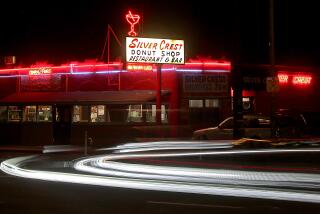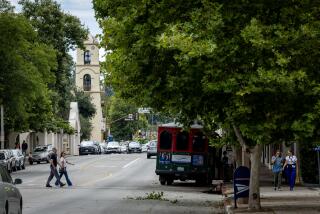Hoboken blinking to life after Sandy, but road back is long
HOBOKEN, N.J. -- Much of Hoboken was still without power Sunday, but it was coming back slowly -- block by block, building by building.
Cheers erupted when the lights went on in the Washington Street business district, which includes Elysian Field Cafe, where patrons were eating with plastic cutlery, and Vito’s Italian Deli across the street, which was not delivering but had a line out the door. Hours later, crowds cheered again when Gov. Chris Christie walked by, shaking hands.
“We were fortunate,” said owner Vito Buzzerio, 50. He and half a dozen workers reopened right after the storm thanks to a borrowed generator. “I just spoke to a couple friends that have local businesses that flooded,” he said. “They’ll be closed for a few months.”
INTERACTIVE: Before and after Hurricane Sandy
It’s been stressful trying to stay open, and not just because the power’s out. Buzzerio, who grew up here and has run the business for 26 years, has his parents staying with him because they had to be rescued from their home to the south in Little Ferry, which flooded during the storm.
Every day seems to bring a new challenge, he said.
“It’s not like you put your head on the pillow and it’s over. It takes a toll,” he said as he stood behind the counter Sunday. “It’s a constant struggle.”
He was offering free coffee and soup with every order. He’s heard about other restaurants that jacked up prices after the storm -- $50 for a whole pizza pie, $5 for slices, for instance. Vito’s offers a chicken cutlet sandwich for $7 to $9, by contrast, that has become so popular he’s considering naming it after Sandy.
“They’re making money now, but the karma will come back to them,” he said.
About 660 volunteers in green vests from the Ridgewood, N.J.-based World Mission Society Church of God went door to door checking on residents Sunday in Hoboken, Queens and Staten Island.
“A lot of people were suffering from depression. But just the fact that people are here to help makes them feel good,” said Mike Schardinger of Edison, who was leading a team around Hoboken. “It’s going from physical needs to spiritual ones. They’re scared about their life -- what’s going to happen.”
A shout went up from Carlos Aponte’s building when the power came back on. He cheered from the street below, excited at the prospect of a hot shower and TV, then wondered: Does this mean the elevator works?
“I live on the fifth floor -- that’s a long way up,” Aponte, 24, said. “I don’t want to be the first one to take it and get stuck in there.”
A construction worker, he’s been off this week, getting hot meals and staying warm over at the Elks Club.
“I know a lot of people not working,” he said. “But the town came together -- the people that have power are helping other people charge phones. I think it made Hoboken a better place. On a regular day, everybody sticks to who you know. Now people have extension cords just hanging out their windows. It gives me hope for the world.”
A few blocks away at St. Matthew Trinity Lutheran Church, about 40 people were taking shelter for the night, and volunteers were preparing for more.
“Even after the lights come back, there will still be people whose houses are uninhabitable,” said church president Mark Singleton. “The city still hasn’t figured out how to transition to the next phase of the recovery.”
He said some of those seeking help were already homeless, unable to take shelter near businesses that lost power or to find a spot at the local homeless shelter, which has been full.
“When the recovery is over, we’ll be kicking people out to homelessness,” he said.
Some of those they have helped during the storm have mental health issues that made it tough to cope, he said.
“We’ve been helping them manage,” he said. “The stress level is cumulative.”
The day after the storm, a panicked friend of his paid $40 for four D batteries before FEMA began giving them out for free.
His wife went back to work in the garment district Thursday, catching a ride with a stranger who needed a third person to get past the new three-person minimum at the Lincoln Tunnel. But he said it’s tough for people to leave with the city still in crisis.
“Going back to work has been stressful, but business has to go on,” he said.
Doctors Without Borders had two staff at the shelter. One of the local volunteers was a retired registered nurse who worked in emergency rooms and Vietnam.
Earlier this week, Rose Orozco, 68, spotted a man at the shelter suffering a heart attack, called 911 and got him help.
“He’s back now,” she said Sunday.
Orozco has defused arguments among the displaced, ensured that elderly evacuees stay warm and have some privacy. They have had people with chronic lung disease, some on oxygen pumps, others who need medication they’ve been able to provide.
“We don’t panic -- we adjust,” she said as volunteers arrived with donated clothing and homemade sweet potato bread (still warm). “In ERs, you’re accustomed to chaos and how to create calm out of chaos.”
“This is a small town, a very unique town, one square mile. This has brought the community together in a way we haven’t seen in years,” she said. “All of a sudden the people who had everything didn’t. The old Hoboken has disappeared, but now those people with money realize how fragile it is. We have all types of people coming in, neighbors meeting for the first time.”
People have volunteered their washing machines so evacuees can wash clothing. A local spa bused over evacuees Saturday and Sunday for free showers.
Orozco is so busy flitting around the church, it’s easy to forget what happened to her home -- flooded. She’s staying with a friend when she leaves, which is rare.
Among those brought to the shelter was Ann Musto, 86, a retired teacher at St. Ann’s School who had to be rescued from Marion Towers senior housing complex by the New Jersey National Guard once flood waters rose too high for her to evacuate. National guardsmen carried her from the building and dropped her off at the shelter in the church hall.
Musto, who uses a wheelchair and walker to get around, has plenty of relatives in the area, but they were all in similar straits.
“They were either as bad or worse off,” she said as she sat at a folding table in the shelter eating a doughnut Sunday while Frank Sinatra crooned from a church stereo.
She has been sleeping on a cot. Volunteers positioned some dividers around it to give her privacy, and gave her a donated blanket to stay warm.
Musto said Orozco and others have taken great care of her, but “I’m ready to go home. Hopefully it won’t last too much longer.”
She had tickets for a table of 10 at a St. Ann’s guild dinner Sunday at the Tricky Tray restaurant in nearby Secaucus. She wasn’t sure what to do, and was hoping the event was canceled. She couldn’t reach any of the other ticket holders, and had heard the restaurant flooded.
“There are people downtown still out of their apartments, they’re still pumping water out, they’re distributing gasoline for people on generators.... Also, we’re worried about the nor’easter that’s coming. We think we can handle it, but that’s another concern,” said Richard Tremitiedi, retired former fire chief who now leads a team of community volunteers.
Police had still blocked of a number of streets, traffic lights were still down in many places, gas stations closed and signs set up with power strips on stoops offering “Feel free to power up!”
At Elysian Fields Cafe, which was packed and serving a limited menu, patrons talked about who was still without power and heat and what they planned to do about work Monday.
Caitlin Bookman, 24, a sales assistant at BCBG in New York, had just returned to Hoboken on Sunday from staying with her parents in Lancaster, Pa. She was itching to get back to her new job.
She usually takes the PATH bus to work, but that’s out of commission due to the storm. There’s a ferry from 14th Street to the Westside Highway where she could then take a cab to work, she said, but that plan is “so inconvenient and extremely expensive” -- especially if the buses are down for weeks.
“It adds up,” she said, plus, “the ferry makes me uneasy -- being on the water. And there’s a nor’easter coming.”
The National Weather Service says the next storm could hit Wednesday or Thursday.
Bookman planned to get up before 6 a.m. to wait for a bus, hoping to arrive in the city by 8:45 a.m.
“We’re anticipating it being horrible,” she said. “I’ve seen it before where the PATH is down and it’s insane -- buses going by you completely full.”
She’s been at her job only eight months, and although her boss is understanding, she doesn’t want to miss more days.
“I feel bad not being there. I’d much rather be there than dealing with this,” she said.
Her roommate, Sara Reese, 23, works at a market research company in the financial district. She usually takes the PATH bus or the ferry from First Street to work in the Trump building, as do a few neighbors.
“We haven’t heard yet if we have to be back,” she said. “As of now, the power in the Trump Building is still out.”
ALSO:
Hurricane Sandy death toll climbs above 110
Uneasy quiet: Sandy brought New York an eerie silence
N.J. begins gas rationing as region rebounds in Sandy’s wake
More to Read
Start your day right
Sign up for Essential California for news, features and recommendations from the L.A. Times and beyond in your inbox six days a week.
You may occasionally receive promotional content from the Los Angeles Times.







